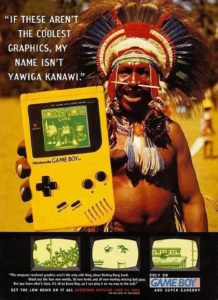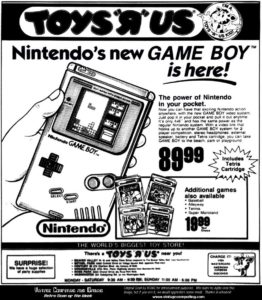Who would have thought that the tale of how the Game Boy becoming the most popular handheld gaming system in the world would be overflowing with handshake deals, underhanded maneuvers, game industry rivalries, licensing battles and tense negotiations between Western businessmen and Soviet officials—all during the cold war, when the relations between the USSR and the Western countries were far from friendly. The whole story seems more like a work of modern fiction than an episode from real life, with some details remaining blurry.
 I still remember waking up on the day my technology-enthusiast dad came home from a shopping trip to Germany and immediately spotting the shiny new present. A box with a grey squared thing in it with a screen and some buttons. Wooow! What was that thing?! It was a Nintendo Game Boy, created back in 1989. I was just a little kid when the first Game Boy came out and I became the coolest kid in the neighborhood, the only one with the shiny new, amazing toy everybody wanted to have.
I still remember waking up on the day my technology-enthusiast dad came home from a shopping trip to Germany and immediately spotting the shiny new present. A box with a grey squared thing in it with a screen and some buttons. Wooow! What was that thing?! It was a Nintendo Game Boy, created back in 1989. I was just a little kid when the first Game Boy came out and I became the coolest kid in the neighborhood, the only one with the shiny new, amazing toy everybody wanted to have.
This toy in its day changed the way people thought about video games and had a huge impact on the world.
But how did it get there? When playing video games, no one really thinks about the background story; you’re focusing on mastering the complex controls or, with games nowadays, admiring the graphics or figuring out the wittiest comebacks to scream into your headset (don’t lie, even though I don’t play nowadays, I still know how it goes). To stick with the 90’s, if you’ve ever played Tetris (and who hasn’t?), you probably spent most of your time thinking and screaming “I need a straight piece, c’mooon!” and I’m willing to bet that you didn’t spend any time thinking about how some lawsuits changed the very course of the whole gaming/esports industry. Well, some of them surely did, and the one concerning the Nintendo Game Boy and Tetris is so iconic and entertaining, it’s definitely worth recapping the story.
What made the Game Boy such an unbeatable success? There were of course some technological factors that meant it easily beat its competitors, such as battery life and affordability, but the signature reason was the game it came with: Tetris. Originally, the toy was supposed to be packed with one of the proven games like Super Mario, but Nintendo of America made the gutsy move of choosing to pack the Game Boy with Tetris. This move proved to be the right one, and essential to long-term success, amongst all ages. As people like to say, “Tetris made Game Boy but Game Boy made Tetris.” But while Game Boy was the thing that made Tetris mainstream, Tetris didn’t start there, and the story of how Nintendo managed to get their hands on the game resembles a rather hilarious sitcom.
Stage one: Moscow, mid-1980s, when the Cold War was in its final chapters, Alexey Pajitnov was working as a researcher at the Dorodnitsyn Computing Centre, part of the Soviet Academy of Sciences. He enjoyed programming and experimenting with simple games on his Elektronika 60. One of these games is based on a puzzle, pentomino, where players had to piece together shapes made of five blocks. Pajitnov wanted to spice up the game a little, having the blocks fall from above and forcing the player to quickly arrange them—they were made of four units.. Yes, we’re describing the now well-known game, Tetris. In the 1980s, however, it was not widely available: you had to know the right people to get access to it. Funny how Pajitnov never really intended to sell it or make any money out of it—but the rest of the world had other plans.
Stage two: still from behind the iron curtain: Budapest, Hungary, in 1986 (I was one year old at the time). Robert Stein, president of the British software company Andromeda, spotted Tetris, which Hungarian programmers had ported to the Apple II and Commodore 64. Stein, seeing the huge potential, wanted to be first in line to get the rights to sell the game, so he flew to Moscow, to seal the deal with Pajitnov himself. Now, here’s where the fun part begins—hold on to your hats ladies and gentlemen, this will be a bumpy ride!
Stage three: back to Moscow. Even though it was indeed Pajitnov who invented the game, he didn’t own any distribution rights to Tetris—the Soviet Academy of Sciences did. The concept of a private individual owning the IP rights to anything was rather alien in the USSR, so Stein was required to negotiate with the Russian government, although he was initially unaware of that. He eventually did realize it, and started discussions with Elektronorgtechnica (Elorg for short), which was a new Soviet government agency created to oversee foreign distribution of Soviet-made software. For a long time, Stein was unsuccessful with Elorg.
However—and this is where the whole story starts to get a little foggy—by then, possibly due to a miscommunication or misunderstanding on Stein’s part, he had already “sold” the rights to Mirrorsoft in the UK and Spectrum Holobyte in the USA—both companies controlled by Robert Maxwell. Stein was determined to have Tetris, allegedly, he even made a plan to essentially steal it and claim that it was invented by the Hungarian programmers. He didn’t need to do that, however, because eventually he was able to secure the rights to the game from Elorg—but only for the IBM PC and compatibles “and any other computer system”, so basically, for PCs. Meanwhile, he was already making promises and deals for console and arcade versions, which the Russians had not approved. Plus, there was this tiny problem that Stein made the deals with Maxwell’s companies before he even had the right to do so.
On the other hand, Tetris was indeed becoming super successful. When the computer versions of the game were released to the public in the West, it was the first Russian pop culture export that many had experienced—it was even sold with the pitch “…from behind the Iron Curtain!” which people bought.
 You may already be lost in this crazy story, in which case I have bad news: this is the point where all hell broke loose. Companies were licensing and sub-licensing rights to Tetris that they didn’t even hold to begin with. The game ended up everywhere, and no one really was able to follow who owned, claimed to own or just simply illegally distributed the game around the world.
You may already be lost in this crazy story, in which case I have bad news: this is the point where all hell broke loose. Companies were licensing and sub-licensing rights to Tetris that they didn’t even hold to begin with. The game ended up everywhere, and no one really was able to follow who owned, claimed to own or just simply illegally distributed the game around the world.
Whether they had the right to do so or not, Mirrorsoft sub-licensed Bullet Proof Software to make Tetris games in Japan, while Spectrum, the USA counterpart, sub-licensed the same rights to Atari regarding Japan and North America. To spice things up a bit, the two Maxwell companies started fighting, and eventually Spectrum got the short end of the stick with Mirrorsoft securing the sub-licensed rights to Bullet Proof in Japan. Although Atari lost the rights to the computer versions there it didn’t stop them from releasing arcade and NES versions of Tetris—which, guess what, they also didn’t have the rights to as they still belonged to Elorg. Even though now the whole licensing scheme was a big mess, it didn’t seem to bother the Russians: the companies were going to battle, but Elorg and the Russian government did not sanction any of the illegal distributions. I guess they had better things to do.
This is where Nintendo came into the picture, and while being a little late to the game, they were the only really successful players in the whole story. While the Nintendo Game Boy was under development, Nintendo of America decided to make Tetris the in-pack game. They entrusted Henk Rogers to get the rights to the game by whatever means necessary. He first got in touch with Stein—remember, the determined fellow, who was also ready to do whatever necessary, even illegally licensing the software. Rogers soon found out about these illegal distribution rights and figured out a backdoor which necessitated the making of a new friend, Pajitnov. Now this may seem like a nice scheme, but the two men actually became really close friends: Rogers got to know the Pajitnov family, and the Russian featured in home videos which Rogers made of his travels.
With Nintendo swooping in, the Russian government was also waking up and getting increasingly defensive about Tetris, and they were suspicious of all the other companies bickering. Rogers was in the right place at the right time, and the Russian government respected the fact that he was making sincere efforts to negotiate directly with them. Rogers finally closed the deal that would change gaming history and determine the fate of the Game Boy: he won exclusive pack-in rights for the game to be bundled with the Game Boy.
Having done that, Nintendo sent a cease and desist letter to Tengen in March 1989 in order to force them to stop selling the NES versions of the Tetris. Having read the story thus far, you have most probably anticipated that they didn’t simply comply—and you were right. Tengen, Atari and Spectrum—the USA side of the Maxwell empire, if you remember—began lobbying harder for the control of the IP. In fact, Tengen even went as far as applying to register copyright of the Tetris IP. It was an undertaking probably doomed from the start, but definitely a bold move, I’ve got to admit.
 In April 1989, Tengen sued Nintendo of America over the issue of ownership of the Tetris IP, and Nintendo countersued. With the support of the Russians, especially Elorg, Nintendo won the case: the US court ruled that neither Mirrorsoft, nor Spectrum ever held any rights to the Tetris IP, thus, they were never able to grant any rights to Atari/Tengen. The court ruled in Nintendo’s favor, Tengen had to stop selling Tetris games and Nintendo was able to package the Tetris with the Game Boy, a toy that sold over 118.69 million units.
In April 1989, Tengen sued Nintendo of America over the issue of ownership of the Tetris IP, and Nintendo countersued. With the support of the Russians, especially Elorg, Nintendo won the case: the US court ruled that neither Mirrorsoft, nor Spectrum ever held any rights to the Tetris IP, thus, they were never able to grant any rights to Atari/Tengen. The court ruled in Nintendo’s favor, Tengen had to stop selling Tetris games and Nintendo was able to package the Tetris with the Game Boy, a toy that sold over 118.69 million units.
Do you know what the most upsetting part of this whole fiasco is? Pajitnov, the original creator of the game, wasn’t seeing a penny from his creation. It’s estimated that he lost out on about 40 million USD in royalties. Eventually, in 1996, he started The Tetris Company, bought the rights for Tetris from the Russian government and now handles all licencing requests. All’s well that ends well, and Pajitnov could finally make some money from his own work.
The legal history of “Tetris” remains a little unclear to this day, even if you could follow the story, you can see that some details are still blurry. If I am honest, however, I have to admit on a daily basis, that this is why our work is so much fun. Even now, writing this article, looking back and trying to put the pieces together in this now 30 year old legal battle. It never stops being challenging and often things are a little unclear for a variety of reasons, and nowadays the lack of regulation in many new emerging sectors is chief among them.
One takeaway from all this is something that we actually keep telling our clients: we can’t emphasize enough the importance of securing your IP and having an undisputed ownership and licensing scheme. Pajitnov should have learned that rule.







